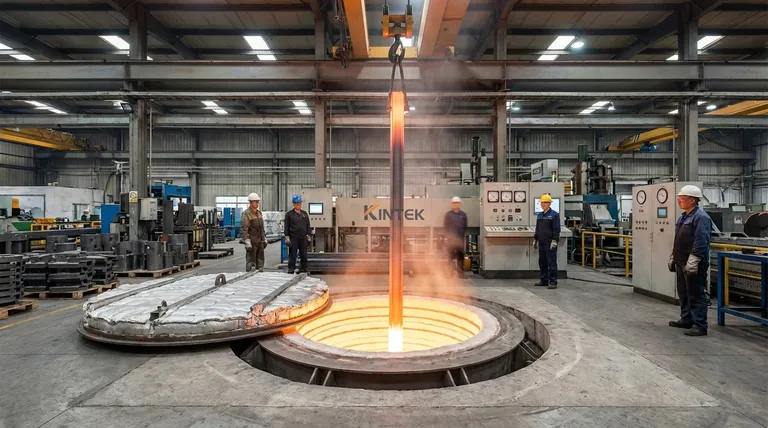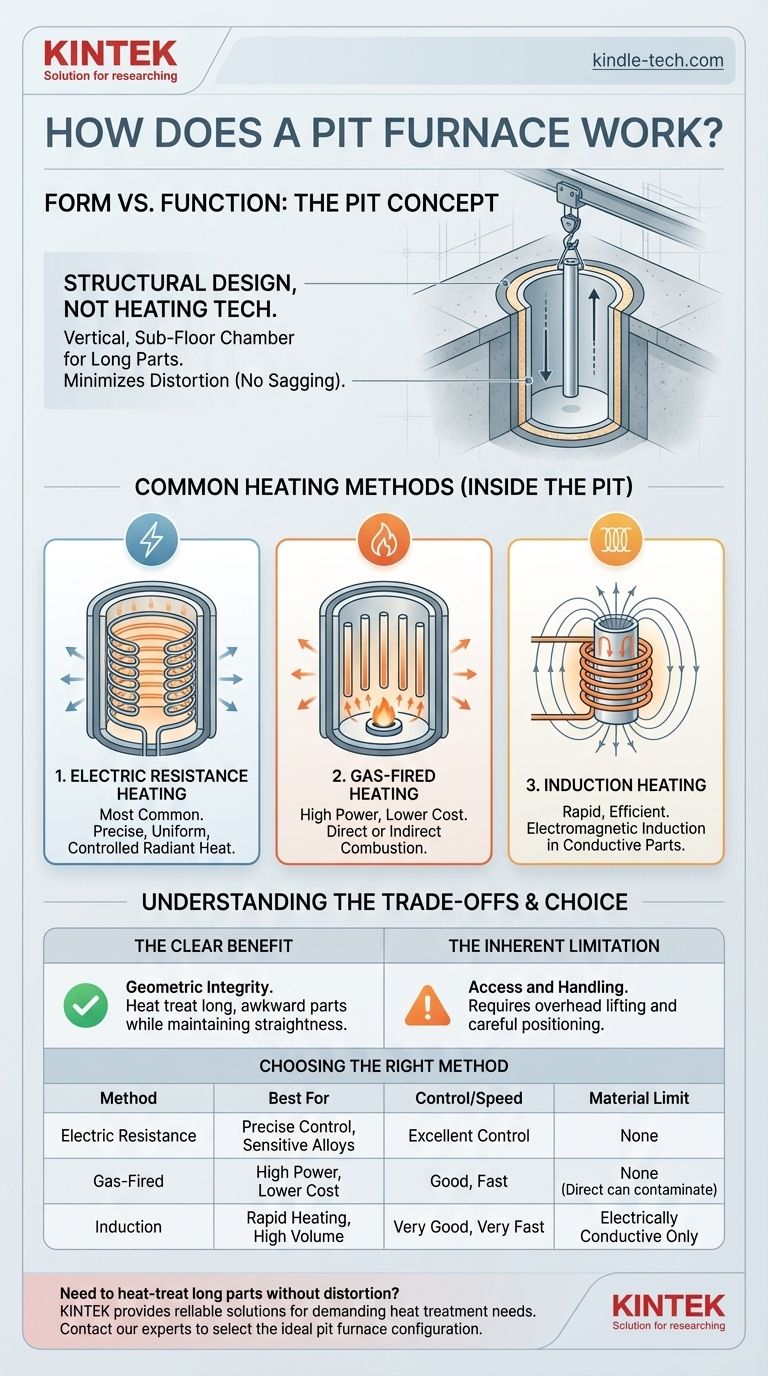"핏 가열로(Pit Furnace)"라는 용어는 열을 생성하는 방식이 아니라 가열로의 물리적 방향을 나타냅니다. 이는 바닥면 아래 구덩이(pit)에 설치되는 수직 가열로로, 고온에서 처짐이나 변형을 방지하기 위해 부품을 수직으로 고정해야 하는 길거나 무거운 부품을 열처리하기 위해 특별히 선택된 설계입니다. 실제 가열은 전기 저항, 가스 연소 또는 유도 가열을 포함한 여러 방법을 통해 수행될 수 있습니다.
핏 가열로는 근본적으로 구조적 설계 선택이지 가열 기술이 아닙니다. 이 가열로의 정의적인 특징은 수직으로 지하에 위치한 챔버이며, 이는 중력으로 인한 변형 없이 샤프트나 튜브와 같은 긴 부품을 처리하는 데 이상적입니다. 이 챔버 내에서 열을 생성하는 데 사용되는 방식은 별개의 중요한 결정 사항입니다.

핏 가열로의 해부: 형태 대 기능
흔히 혼동되는 지점은 가열로의 모양을 에너지원으로 착각하는 것입니다. 실제로는 "핏(pit)" 구성이 특정 기계적 문제에 대한 해결책이며, 가열 요소는 열적 문제에 대한 해결책입니다.
정의적 특징: 수직, 바닥 아래 챔버
이 가열로는 공장 바닥의 구덩이 속에 설치된 원통형 또는 직사각형의 단열 챔버로 구성됩니다.
부품은 일반적으로 오버헤드 크레인을 사용하여 위쪽에서 수직으로 장입 및 배출됩니다. 이 설계는 가열로의 본체가 방해되지 않도록 하여 귀중한 바닥 공간을 절약합니다.
핵심 목적: 변형 최소화
핏 가열로를 사용하는 주된 이유는 열처리 중 길고 가느다란 부품에 대한 중력의 영향을 관리하기 위함입니다.
긴 샤프트, 튜브 또는 나사를 수평 가열로에서 고온으로 가열하면 자체 무게로 인해 구부러지거나 처질 수 있습니다. 부품을 수직으로 매달아 놓으면 이러한 변형 응력이 제거되어 치수 안정성이 보장됩니다.
핏 가열로에서 사용되는 일반적인 가열 방식
핏(모양)은 형태를 정의하지만, 내부의 기술이 열을 생성합니다. 가열 방식의 선택은 재료, 요구되는 온도 정밀도 및 운영 비용에 따라 달라집니다.
전기 저항 가열
이는 어닐링, 템퍼링 및 경화와 같은 열처리 응용 분야에 사용되는 핏 가열로에서 가장 일반적인 방식입니다.
일반 오븐과 마찬가지로 전기 발열체가 가열로 내부 벽을 따라 배치됩니다. 전류가 이 고저항 요소들을 통과하면서 균일하고 정밀하게 제어되는 복사열을 생성합니다.
가스 연소 가열
정밀한 온도 제어보다 순수한 가열 능력과 낮은 운영 비용이 덜 중요할 때 사용되는 응용 분야의 경우 가스 연소 시스템이 사용됩니다.
버너가 천연가스나 프로판과 같은 연료를 연소시킵니다. 이는 연소 생성물이 챔버로 들어가는 "직접 연소(direct-fired)" 방식이거나, 불꽃이 복사 튜브를 가열하여 챔버를 가열하는 "간접 연소(indirect-fired)" 방식일 수 있으며, 이 경우 가열로가 공작물을 불꽃으로부터 보호합니다.
유도 가열
유도 가열로의 원리에 설명된 바와 같이, 이 방식은 전자기장을 사용하여 공작물 자체 내부에 직접 열을 생성합니다.
핏 가열로의 맥락에서, 구리 코일이 전도성 금속 부품 주위로 챔버 내부로 내려집니다. 코일에 흐르는 교류는 부품 내부에 강력한 와전류(eddy currents)를 유도하여 부품이 내부에서부터 빠르고 효율적으로 가열되도록 합니다. 이 방식은 예외적으로 빠르지만 전도성 재료로 제한됩니다.
절충점 이해하기
핏 가열로와 그 가열 시스템을 선택하는 것은 뚜렷한 장점과 한계 사이의 균형을 맞추는 것을 포함합니다.
분명한 이점: 형상 무결성
가장 큰 장점은 길고, 까다롭거나, 무거운 부품을 열처리하면서도 곧은 상태와 치수 정확도를 유지할 수 있다는 것입니다. 항공기 착륙 장치, 대형 산업용 샤프트 또는 총열과 같은 부품의 경우 이는 필수적입니다.
내재된 한계: 접근 및 취급
지하 설계는 수평 또는 박스형 가열로에 비해 유지 보수를 위한 접근이 복잡할 수 있습니다. 장입 및 배출 시에도 신뢰할 수 있는 오버헤드 리프팅 장비와 공작물의 신중한 위치 지정이 필요합니다.
가열 방식이 성능을 결정함
전기, 가스 또는 유도 방식 사이의 선택은 중요한 상충 관계입니다.
- 전기 저항 방식은 가장 우수한 온도 균일성과 제어 기능을 제공하여 민감한 합금에 중요하지만 운영 비용이 더 높을 수 있습니다.
- 가스 연소 방식은 종종 운영 비용이 저렴하고 막대한 가열 전력을 제공하지만, 온도 제어 정밀도가 낮고 직접 연소 설계의 경우 대기 오염 가능성이 있습니다.
- 유도 방식은 가장 빠르고 에너지 효율적인 방식이지만, 장비가 특수하며 전기적으로 전도성이 있는 재료에만 작동합니다.
목표에 맞는 올바른 선택하기
이상적인 가열로는 올바른 물리적 형태와 해당 작업에 적합한 가열 기술의 조합입니다.
- 변형 위험이 있는 길고 가느다란 부품 처리가 주된 초점이라면: 가열 방식에 관계없이 핏 가열로가 올바른 물리적 구성입니다.
- 민감한 합금을 위해 정밀하고 균일한 온도 달성이 주된 초점이라면: 전기 가열식 핏 가열로가 제어 및 청결성 면에서 우수한 선택입니다.
- 전도성 부품의 대량 처리를 빠르고 효율적으로 수행하는 것이 주된 초점이라면: 핏 가열로 내부에 설치된 유도 가열 시스템은 비할 데 없는 속도와 에너지 효율성을 제공합니다.
궁극적으로 올바른 산업용 가열로를 선택하는 것은 장비의 설계와 기능을 특정 재료 및 생산 목표에 맞추는 것을 의미합니다.
요약표:
| 특징 | 전기 저항 | 가스 연소 | 유도 |
|---|---|---|---|
| 가장 적합한 용도 | 정밀 온도 제어, 민감한 합금 | 고출력, 낮은 운영 비용 | 빠른 가열, 전도성 금속 |
| 온도 제어 | 우수 | 양호 | 매우 우수 |
| 가열 속도 | 보통 | 빠름 | 매우 빠름 |
| 재료 제한 | 없음 | 없음 (직접 연소 시 오염 가능) | 전기 전도성 재료에 한함 |
변형 없이 길고, 무겁거나, 가느다란 부품을 열처리해야 합니까?
KINTEK은 실험실 장비 및 소모품을 전문으로 하며, 까다로운 실험실 및 산업용 열처리 요구 사항에 대한 안정적인 솔루션을 제공합니다. 당사의 전문 지식은 귀하의 구성 요소가 형상 무결성을 유지하고 정확한 재료 사양을 충족하도록 보장하기 위해 이상적인 핏 가열로 구성(전기식, 가스식 또는 유도식)을 선택하는 데 도움을 드릴 수 있습니다.
지금 바로 전문가에게 문의하여 귀하의 응용 분야에 대해 논의하고 목표에 맞는 올바른 가열로를 찾아보십시오!
시각적 가이드

관련 제품
- 수직 실험실 석영 튜브 퍼니스 튜브형 퍼니스
- 1400℃ 실험실용 알루미나 튜브 머플로
- 알루미나 튜브가 있는 1700℃ 실험실 석영 튜브 퍼니스 튜브 퍼니스
- 1700℃ 실험실용 머플로 퍼니스
- 실험실용 1800℃ 머플로 퍼니스



















